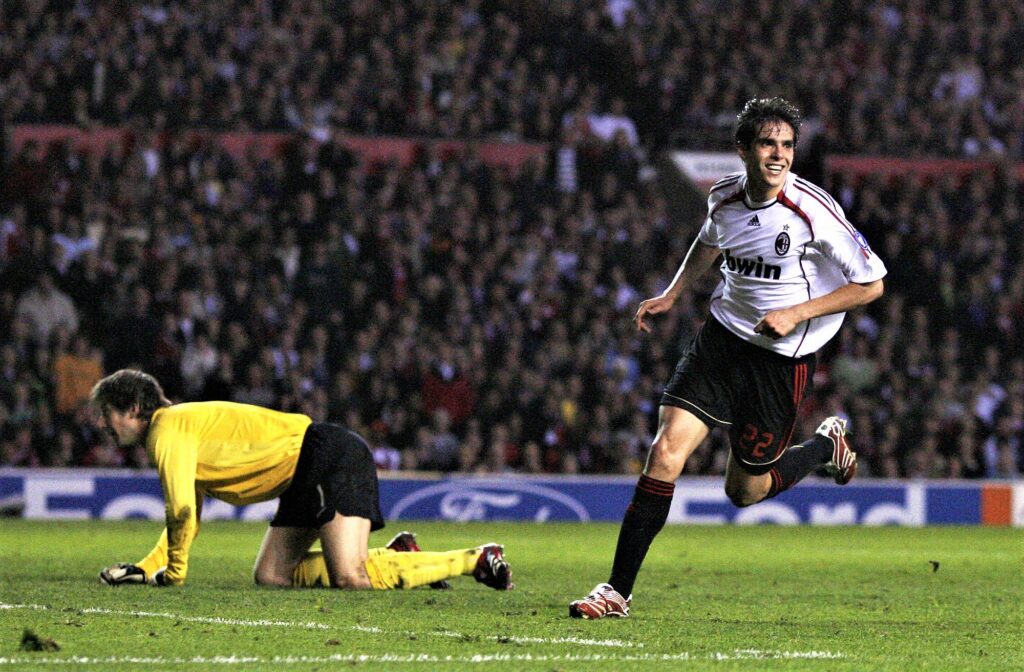
“I believe my best match was against Manchester United, in the Champions League, at Old Trafford”
“That night was magical”
That night marked one of the greatest individual performances in the history of the Champions League. The final result was a 3-2 loss for Milan, who played away at Old Trafford in the first leg of the 2006/07 UEFA Champions League semi-final. While Milan’s 3-0 win in the second leg can be remembered as a brilliant collective show, Kaká was the one responsible for keeping the Rossoneri’s hopes alive in the first leg. Going into half-time with a 2-1 lead, the Brazilian’s two goals marked a brilliant first-half display. This article closely examines Kaká’s contribution, reliving the Ballon d’Or winner’s historical performance. From the tactical context to the details behind his game, this individual analysis provides an in-depth look at Kaká’s night.
This analysis is, hopefully, the first of a series of articles providing a detailed look at various Brazilian legends of the past.
To contextualise the Brazilian’s game, it is important to understand the tactical dynamics surrounding his contribution. The number 22 started as the central attacking midfielder in a 4-4-1-1 formation. With Dida in goal, Massimo Oddo, Alessandro Nesta, Paolo Maldini, and Marek Jankulovski completed the back four. The midfield four consisted of Andrea Pirlo and Massimo Ambrosini flanked by Gennaro Gattuso and Clarence Seedorf. Finally, Kaká played behind Alberto Gilardino, the centre-forward.
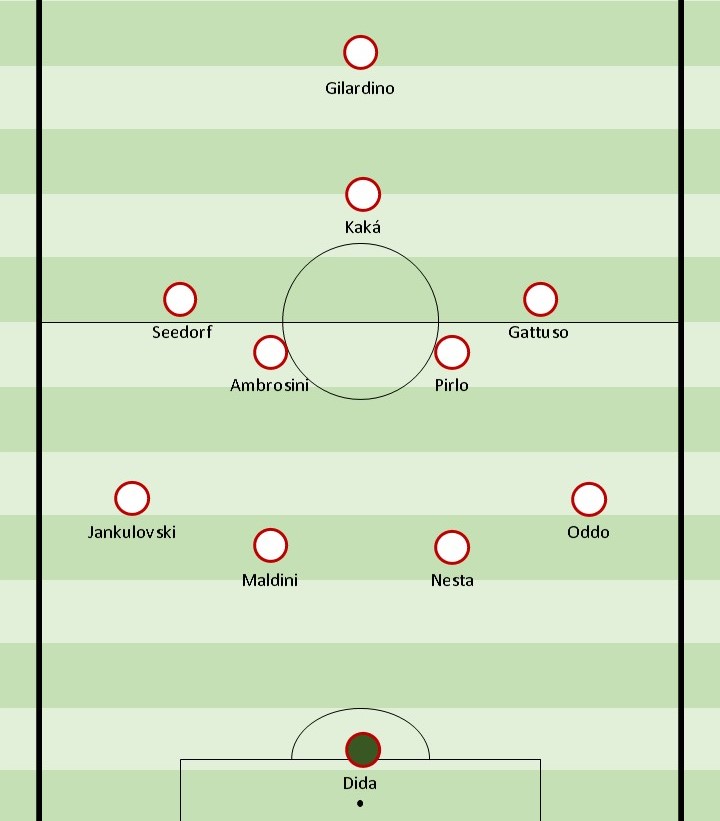
Kaká’s role within the structure is better understood in context with the rest of the midfield. As a starting point, Pirlo and Ambrosini sat as the central and deeper midfielders while Seedorf and Gattuso filled the left and right flanks, respectively. In moments where Milan had controlled possession and looked to construct their attacks, this organisation was characterised by a structural instability typical of Carlo Ancelotti’s teams.
This instability, where a numerical shape would be unrecognisable at times, was caused by the fluid and spontaneous movements of the midfield four. Aspects such as width, distance, and rotations were constantly and naturally changing; in other words, it was difficult to observe any imposed positional patterns. Kaká typically sat at the top of this structure, continuously interacting with the affordances resulting from this fluidity. The fullbacks supported the structure on either wing, with simple but very important dynamics.
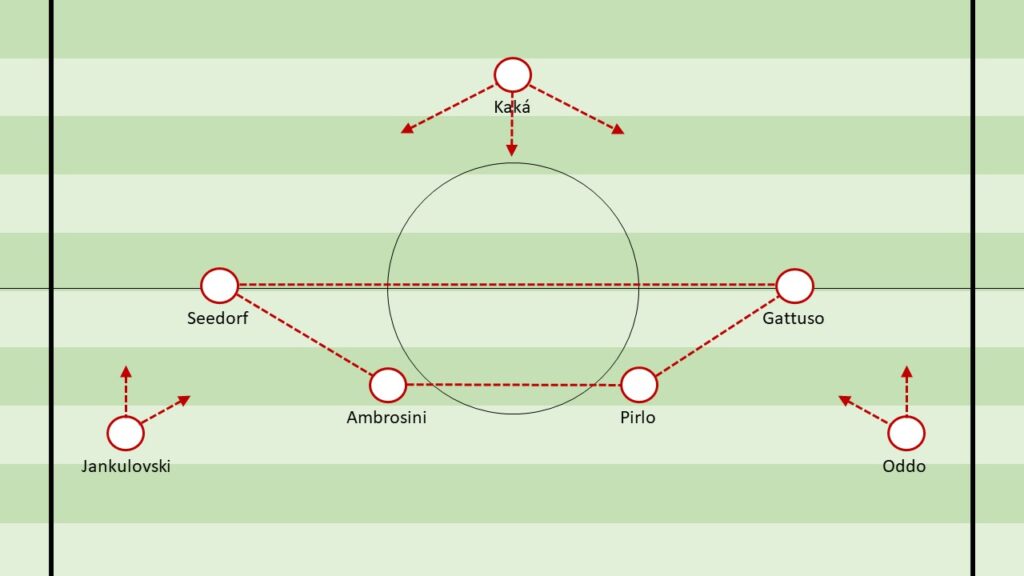
With a clearer idea of Milan’s structural dynamics, it is easier to understand how Manchester United interacted with this midfield. The Red Devils looked to sit in a 4-5-1 block, often relieving the advanced forward of any defensive duties. This player was typically Wayne Rooney, although Cristiano Ronaldo would take the rest sometimes.
The unit of five across the midfield looked to stay compact, respecting a relatively zonal organisation. Michael Carrick sat in the central position with Paul Scholes and Darren Fletcher on either side. Ronaldo and Ryan Giggs were the wide players.
With a zonal behaviour, the line of five usually moved compactly and in unison, picking up temporary man-marking duties in relation to the ball and Milan’s movements. For instance, if Seedorf were to move into a winger position, Giggs would pass him on to John O’Shea and advance on Jankulovski. This framework guided United’s tactics out of possession in the match.
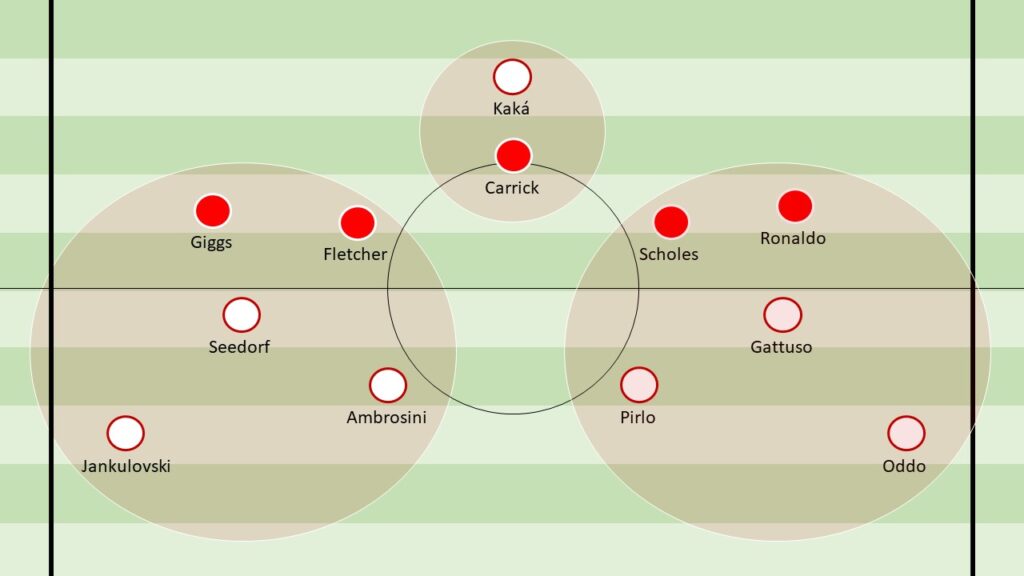
Together, the combination of these tactics raised some interesting dynamics. Most significantly, Milan’s fluidity required a lot of attention from United’s zonal block, particularly on the left side. While Ferguson’s men did a good job of containing Milan’s stars, the Rossoneri found a few opportunities through this confusion.
The example below provides a brief visualisation of these mechanics. Gattuso begins the clip with the ball before finding Seedorf. Right off the bat, the two wide midfielders are right next to each other in a central area. Pirlo and Ambrosini are both on the left-hand side, where the ball ends up being played. The disruption of the midfield organisation was a consistent feature in Milan’s controlled attacks.
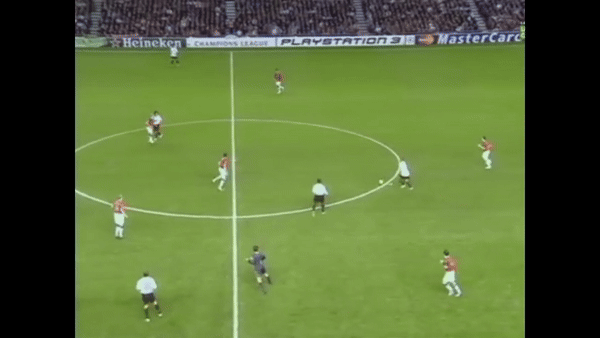
In the wide areas, the absence of fixed wide attackers posed a question for United. Before any fluidity, Seedorf and Gattuso’s positioning began much deeper, discouraging United’s fullbacks from initially stepping up to mark them. This would create temporary advantages for Milan, outnumbering the Red Devils in the deeper wide areas. However, these were only exploited in instances where Milan increased the tempo and verticality of possession. Otherwise, United were very good at shifting the defensive block across to close the distances and stop progression. These dynamics can be observed below, with another note to the positioning of Milan’s midfield four.
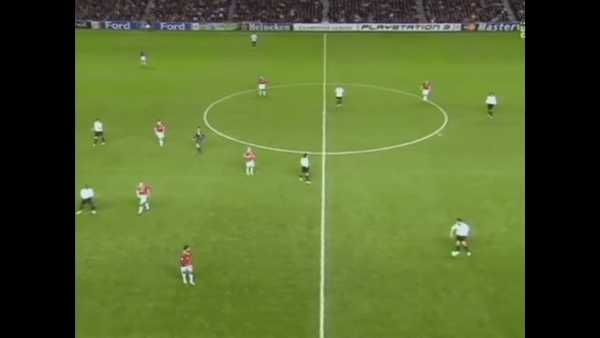
Enter Kaká. The Brazilian looked to position himself in between United’s midfield and backline, making Carrick’s evening a very difficult one. Kaká often stayed directly behind Carrick, making it very hard for the English player to keep track of him. From this, Kaká would then look for spaces to receive the ball. Additionally, he alternated between fixing Carrick in a central position and moving wide. In United’s zonal block, Carrick would not always follow him, which created a few advantageous scenarios. Either way, the Brazilian’s tactical game consisted of working off Michael Carrick to manipulate and exploit the opposition’s defensive block, particularly with the help of Milan’s fluid midfield structure and legendary quality. The two examples below help illustrate the foundation for Kaká’s tactical behaviour.
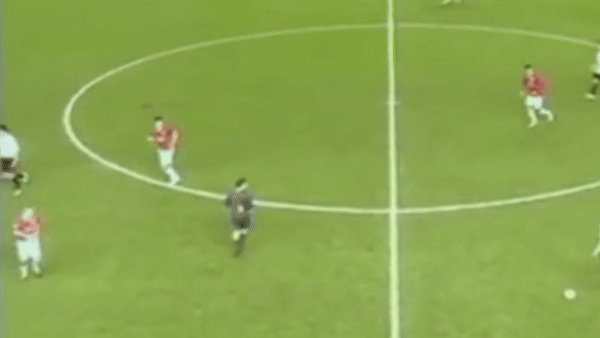

In this role, Kaká was a very useful tactical resource for Milan’s progression. The number 22 was consistently able to find pockets of space to receive the ball throughout the match, and there were a few qualities that took him from simply being in a good position to actually exploiting that. The instance below highlights the intelligence to work off his surroundings; namely, the run from Gilardino and Carrick looking at the ball. This is exploited through a nicely timed run with a glance at the centre-back, which allows him to see the pressure coming and make the decision to play the ball back with his first touch before moving again.
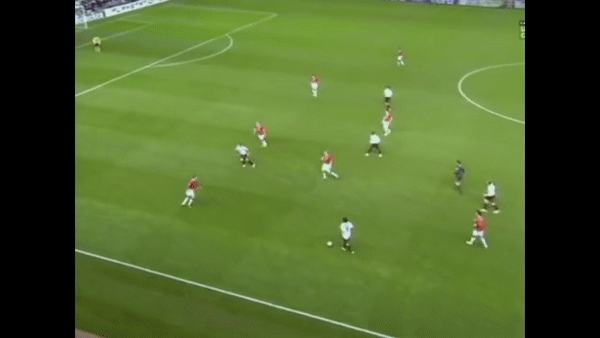
This second example provides an interesting look at how he communicates with the ball carrier. Kaká is positioned directly behind Carrick as Gattuso brings the ball up. As the Italian lines up for the pass, Kaká flexes his knees with a jump to his right. While this is a simple action, it takes him from simply being positioned between the lines to turning that into a communicated passing lane. Being closed down by three players, he displays good decision-making and awareness to release it first-time to Ambrosini, who progresses the play forward.
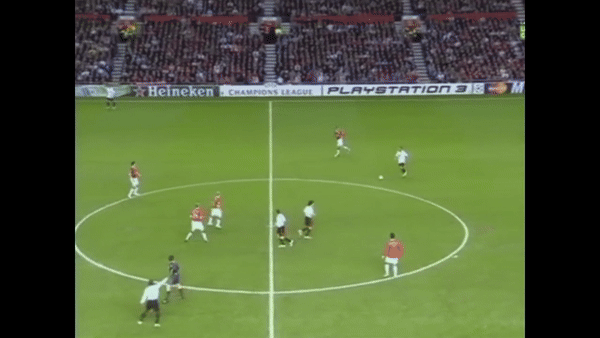
Again connecting with Gattuso and working off Carrick’s back, Kaká now makes a run to receive the ball into a “future point”, where he immediately finds Pirlo to attack the right wing.
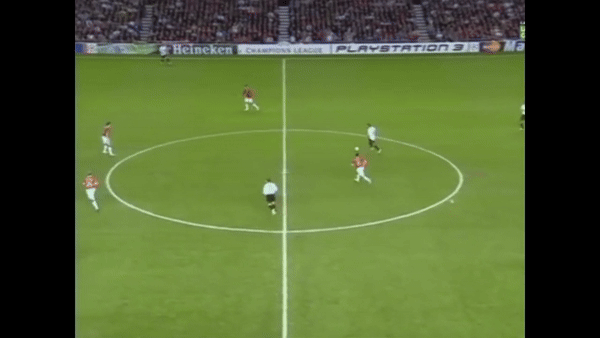
Whether making a run into space or receiving between the lines, the many details behind Kaká’s game contributed to him being a very dangerous player in Milan’s tactical setup. From that, Kaká had a consistently positive performance. The Brazilian rarely lost possession, and when utilised, he was very useful in retaining and progressing the attack. This consistency can be attributed to a very fast ability to make good decisions, stemming from a clear awareness of his surroundings. Of course, there is the technical ability to support this positivity, but it is important to first visualise this decision-making.
In this first instance, receiving the ball in between the lines, he realises the proximity of United’s midfielders in front of him and the space between him and the centre-backs. This informs his decision to open his body and take his first touch on the turn. After turning, he attacks the backline before a chop to maintain control in a quick 1v1 scenario and move the ball wide.
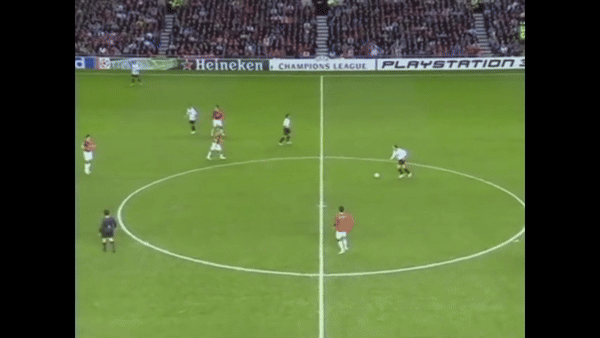
In a simpler example, he receives the ball in an attacking transition. The scan before receiving informs him of the 1v5 Gilardino is in. He then uses this information to retain possession and move it away from pressure rather than launching a disadvantageous counter-attack. While a simple example, it helps illustrate the decision-making process behind such a positive performance.
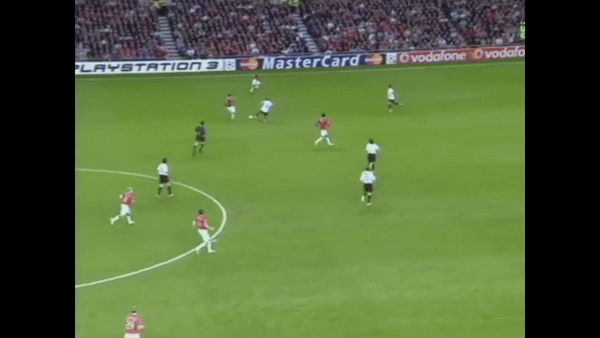
This decision-making was on display for his first goal of the evening. The Brazilian makes a nicely timed run between the lines to receive the pass from Seedorf. With an incredibly intelligent first touch, Kaká skips past the entire backline and finishes perfectly into Edwin van der Sar’s far side.
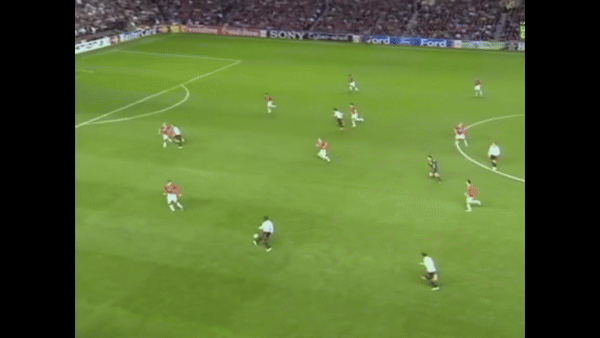
Underpinning his entire game, the Brazilian’s technical ability was on full display. As explored, he was often in situations where the spaces were tighter and the window for action was small. Guided by his rare awareness and consistently good decision-making, his technical ability made him incredibly effective on the ball. Continuing with the context of this match, we can explore a few scenarios where this was showcased.
A few seconds into the game, his extensive technical arsenal was on display. After receiving a longer pass in the air, the Brazilian beautifully chests the ball down before safely passing it in a controlled yet difficult motion.
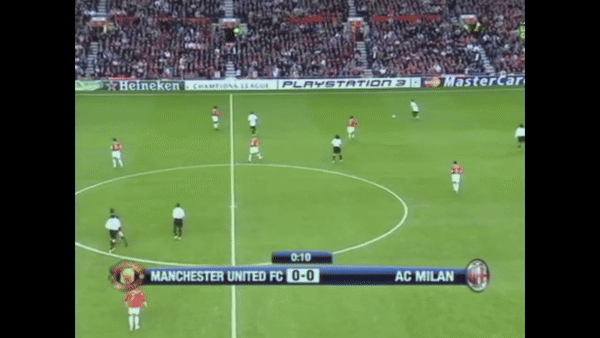
In a scenario explored many times in this article, Kaká receives the ball between the lines with a beautiful scoop to drag the ball onto his right foot while turning at the backline. This instance perfectly illustrates how his technical ability, coupled with his decision-making and awareness, made him an incredibly efficient yet elegant player. With one touch, he takes a defender out of the game, turns, and sets up his pass behind the backline.
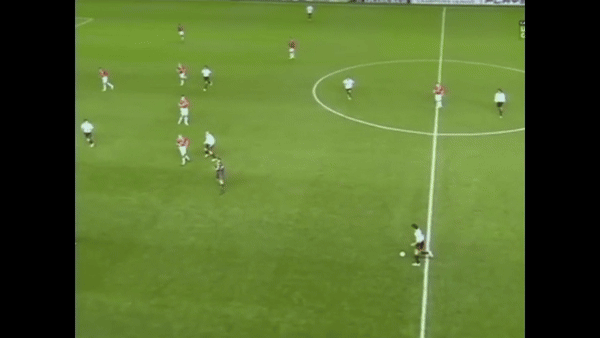
The second half became a much more vertical game for Milan, without many controlled attacks in the final third. While the team collectively lost the ability to impact the game offensively, Kaká still had a few positive actions. For example, to take advantage of Seedorf’s overlap, Kaká allows himself to get close to United’s defender. The Brazilian performs a stepover at the last minute to manipulate the defender into diving in before immediately playing the overlapping pass for Seedorf to cross the ball.
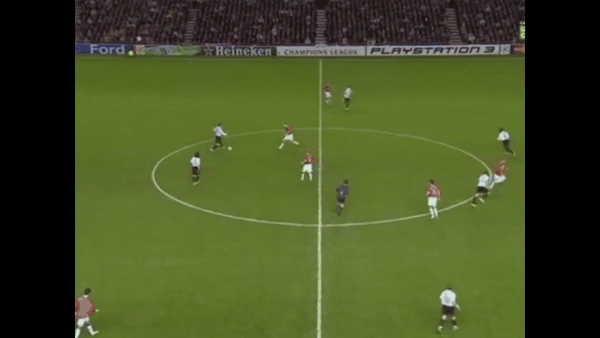
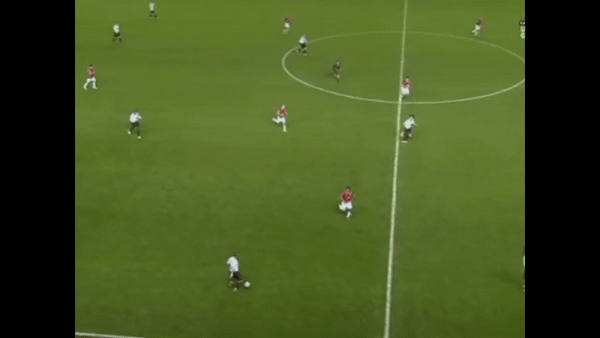
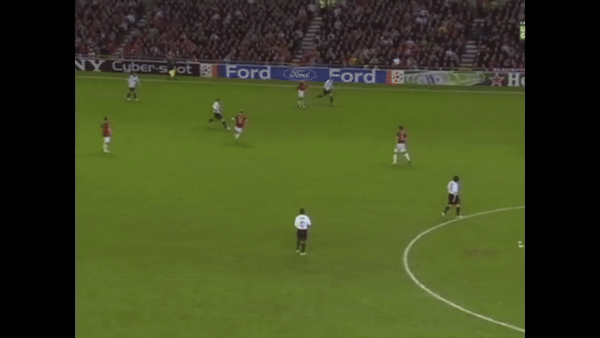
And to finish, one of the most beautiful goals in the history of the Champions League.
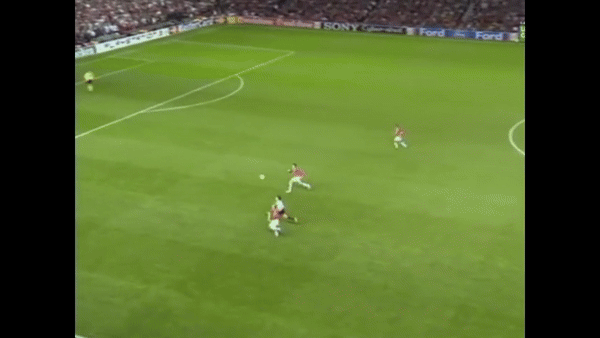
Kaká’s performance at Old Trafford went down as one of the most memorable in his illustrious career, and it is the perfect example to take a closer look at what made the Brazilian such a historic player. He is often remembered as an elegant and technical player, but hopefully, with this article, this image can be visualised with a little more detail.
